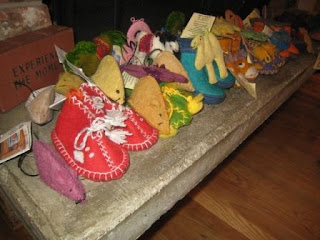Cheryl shared some recent experiences, including spending two weeks at the John C. Campbell Folk School. She also signed some books, and told us that her husband creates the linocuts found on her books. On Cheryl's needles was a multi-directional scarf in Noro sock yarn.

Siri joined us shortly before 8 pm, because she was busy minding a Snow Leopard Trust booth at the Alive Expo earlier in the day. She told us about the history of the Snow Leopard Trust, their research to learn more about snow leopards, and how yarn and felt help conserve the snow leopard population. Snow leopards are killed for two main reasons: first, for food and traditional medicine ingredients, and second, in retaliation for killing herd animals. If the herders have other ways of getting food and money, they won't kill the snow leopards for their meat, pelt, and bones. And if they have enough money to provide for their families, they don't feel the need to retaliate when a snow leopard kills one of their herd.
To help herders improve their economic situation, the Snow Leopard Trust has taught them to spin high-quality yarn, and then buys that yarn at a fair price. Siri told us about a Mongolian woman who was spinning with a drop spindle made out of an old spoon when they first contacted the herders. Now women can take out microloans for spinning wheels. The women also make felt, and then make slippers, booties, ornaments, hats, glasses cases, toys, and many other things out of the felt.
 Siri brought several lovely items that the Snow Leopard Trust sells. She brought several skeins of hand-spun and hand-dyed camel yarn in brilliant jewel tones. She also brought some undyed yak yarn. Both yarns were soft, but the camel yarn was surprisingly downy. The herders had never tried spinning yak yarn - and so they have found a new source of income that they never had before. Siri also brought the aforementioned felt items - baby booties, mouse-shaped cat toys, and ornaments. She told us the two ways that felt is made - by several women wetting and manually kneading the wool, or more traditionally, rolling it up in a mat and dragging it behind a horse. She showed us an album with several photographs of Mongolian and Kyrgyzstani women preparing the wool (by whipping it), spinning it, and turning it into felt, in and around their yurts.
Siri brought several lovely items that the Snow Leopard Trust sells. She brought several skeins of hand-spun and hand-dyed camel yarn in brilliant jewel tones. She also brought some undyed yak yarn. Both yarns were soft, but the camel yarn was surprisingly downy. The herders had never tried spinning yak yarn - and so they have found a new source of income that they never had before. Siri also brought the aforementioned felt items - baby booties, mouse-shaped cat toys, and ornaments. She told us the two ways that felt is made - by several women wetting and manually kneading the wool, or more traditionally, rolling it up in a mat and dragging it behind a horse. She showed us an album with several photographs of Mongolian and Kyrgyzstani women preparing the wool (by whipping it), spinning it, and turning it into felt, in and around their yurts.Everyone had a fantastic time - we learned from a knitting master and discovered a new aspect of knitting that we had never thought of before.

No comments:
Post a Comment